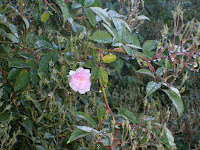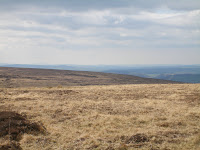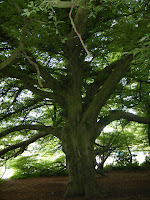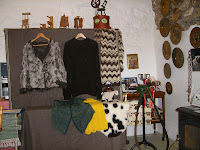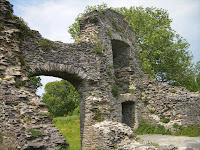Click to enlarge - ferns growing on the lane bank locally. One of my better photos . . .

Yarrow has requested that I post the recipe for the Chocolate Cinnamon Cake I made last week (though forgot to take a photo of!) I am also baking White Chocolate Chip cookies this morning, so will add that recipe too, and update with a photo if I don't burn them to a cinder (oven playing up).
CHOCOLATE CINNAMON CAKE WITH BANANA SAUCE(I didn't bother with the banana sauce).
4 oz (115g) plain chocolate, chopped
Same amount of unsalted butter, at room temperature
1 tablespoon instant coffee powder
5 eggs, separated
7 oz (200g) granulated sugar (I used caster sugar)
4 oz (115g) flour (S-R)
2 teaspoons ground cinnamon
For the Sauce:
4 ripe bananas
2 oz (50g) soft light brown sugar, firmly packed
1 tablespoon resh lemon juice
6 fl oz (175ml) whipping cream
1 tablespoon rum (optional)
Preheat the oven to 180 deg. C/350 deg. F/ Gas 4). Grease an 8 inch (20cm) round cake tin.
Combine the chocolate and butter in the top of a double boiler or in a heatproof bowl set over hot water and stir until melted. Remove from the heat and stir in the coffee. Set aside.
Beat the egg yolks with the sugar until thick and lemon-coloured. Add the chocolate mixture and beat just to blend the mixtures evenly.
Sift together the flour and cinnamon into a bowl.
In another bowl, beat the egg whites until they hold stiff peaks. Fold a dollop of whites into the chocolate mixture to lighten it. Fold in the remaining whites in three batches, alternating with the sifted flour.
Pour the mixture into the prepared tin. Bake until a skewer inserted in the centre comes out clean - 40-50 mins. Unmould the cake onto a wire rack.
For the sauce - preheat the grill. Slice the bananas into a shallow, heatproof dish. Add the brown sugar and lemon juice and stir to blend. Place under the grill and cook, stirring occasionally, until the sugar is cramelized and bubbling - about 8 mins.
Transfer the bananas to a bowl and mash with a fork until almost smooth. Stir in the cream and rum, if using. Serve the cake and sauce warm.
(It's nice cold too, and gorgeous with a dollop of ice cream . . .) Meant to serve 6!
Chocolate Chip Cookies
Makes 24
4 oz (1115g) butter or marg, at room temperature1 3/4 oz (50g) caster sugar
3 3/4 oz (110g) dark brown sugar
1 egg
1/2 tsp vanilla essence
6 oz (170g) plain flour
1/2 tspn bicarbonate of soda
1/8 tspn salt
6 oz (170g) chocolate chips (I am using white and cheating by just chopping up a bar of white chocolate - don't pay extra for little bags of specially-shaped "chips" - I never buy those)
2 oz (55g) walnuts, chopped (I will omit as my son doesn't like them)
Preheat the oven to 350 deg. F/180 deg. C/Gas 4. Grease 2 large baking sheets.
With an electric mixer, cream the butter or marg and two sugars together until light and fluffy.
In another bowl, mix the egg and vanilla, then gradually beat into the butter mixture. Sift over the flour, bicarb. of soda and salt and stir. Add the choc. chips and walnuts and stir well to combine.
Place heapted teaspns of the dough 2 inches (5 cm) apart on the prepared sheets. Bake until lightly coloured - 10 or 15 mins. Transfer to a rack to cool.
Both these recipes came from a book "Complete Baking" by Martha Day, which my son bought me for Christmas one year.
 Here is just one part of the children's class for animal made from a vegetable! These made me smile.
Here is just one part of the children's class for animal made from a vegetable! These made me smile. I took a quick photo of the flower displays on my way out.
I took a quick photo of the flower displays on my way out. Up at the top end of the showground were the sheep and cattle classes. Here is a splendid Jersey cow (how she walked with SUCH a full udder I don't know! If my memory serves me rightly, I think her colour may be called Mulberry - the deepest Mulberry is black, but I think it ranges through grey too. A change from the usual golden Jerseys though.
Up at the top end of the showground were the sheep and cattle classes. Here is a splendid Jersey cow (how she walked with SUCH a full udder I don't know! If my memory serves me rightly, I think her colour may be called Mulberry - the deepest Mulberry is black, but I think it ranges through grey too. A change from the usual golden Jerseys though. One of the beef breeds - I don't know which one but it has a blackside like a Belgian Blue or Limousin, only the colour's wrong!
One of the beef breeds - I don't know which one but it has a blackside like a Belgian Blue or Limousin, only the colour's wrong! Children showing a fine trio (look a bit like Suffolks to me).
Children showing a fine trio (look a bit like Suffolks to me). I know that these gorgeous sheep are Hampshire Downs as I spent some time talking to their owner.
I know that these gorgeous sheep are Hampshire Downs as I spent some time talking to their owner. A cracking ewe, though I don't know the breed.
A cracking ewe, though I don't know the breed. The initial line-up for the ridden Section C Welsh class.
The initial line-up for the ridden Section C Welsh class. One of the entrants for the ridden Shetland Pony classes with his very smart mum.
One of the entrants for the ridden Shetland Pony classes with his very smart mum. How's that for action? What all the Welsh Cob enthusiasts at the ringside come to see!
How's that for action? What all the Welsh Cob enthusiasts at the ringside come to see! One of the entrants for the coloured classes. LOTS of feather, but personally I'm an Arab fan . . .
One of the entrants for the coloured classes. LOTS of feather, but personally I'm an Arab fan . . .





